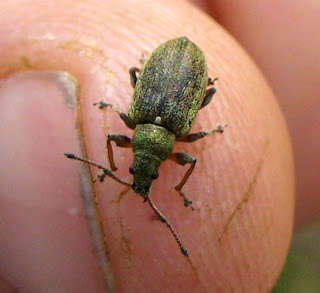Dasineura ulmaria is a common galler of meadowsweet Filipendula ulmaria leaves, forming reddish-pink pouches with a hairy opening on the underside. However, in recent years (and indeed before, though less commonly), similar galls have been found on dropwort Filipendula vulgaris but with projections and openings on the upper sides of the leaves (see Harris 2010 for details of material seen between 2002 & 2009). As described in Redfern (2011, pp. 147-150), the newly hatched larva of D. ulmaria settles on a young leaf, and as it feeds, nutritive tissue develops beneath and around it, with cells growing and dividing to envelop it. This is typical of much insect-mediated gall formation where larval feeding induces gall production, although the precise mechanisms are porrly understood.With D. ulmaria eggs being laid on the underside of the leaf, the gall also has its opening here, unlike the galls on F. vulgaris as noted above.
 |
| Dasineura galls on F. vulgaris |
 | |
| Dasineura gall on a single leaf of F. vulgaris. Note the hole towards the left which may be generalised plant-feeding damage or could be a potential predator of the enclosed larva. |
 |
| Upper side of a F. vulgaris leaf showing two gall projections and openings. |
 |
| Close-up of the gall openings showing fringing hairs and elongated cells of the conical projections. |
 | |
| Enlarged cells on the outside of the gall, highlighted by reddening/darkening along ribs and veins. |
 |
| The tiny (approx. 1mm long) larva in situ showing its yellow colour and segmentation. Also note the somewhat spongy texture of the nutritive cells lining the inside of the gall. |
As noted by Harris (2010), this gall has been described previously - as D. ulmaria by some authors and D. harrisoni by others, although it may of course turn out to be genuinely undescribed. Therefore, until further work can be undertaken (e.g. on the host range of D. ulmaria and the identity of D. harrisoni which is unclear), this gall is to be treated as distinct but undescribed i.e. Dasineura (undescribed sp. A on F. vulgaris) - evidence that even in over-populated (and entomologist-laden) southern England, new species await discovery!
As ever, watch this space - if there are further developments I hope to be able to post them here.
References
Harris, K. (2010). Notes on gall midge galls recorded on Filipendula ulmaria and F. vulgaris in the United Kingdom. Cecidology 25(1): 6-10.
Redfern, M. (2011). Plant Galls. Collins, London.
Smith, K.G.V. (1989). An introduction to the immature stages of British flies. RES Handbooks for the Identification of British Insects 10(14):1-280.






















